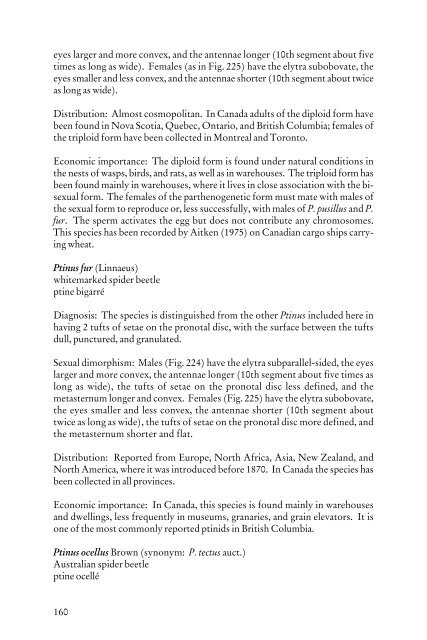Beetles Identification Guide
Beetles Identification Guide
Beetles Identification Guide
Create successful ePaper yourself
Turn your PDF publications into a flip-book with our unique Google optimized e-Paper software.
eyes larger and more convex, and the antennae longer (10th segment about five<br />
times as long as wide). Females (as in Fig. 225) have the elytra subobovate, the<br />
eyes smaller and less convex, and the antennae shorter (10th segment about twice<br />
as long as wide).<br />
Distribution: Almost cosmopolitan. In Canada adults of the diploid form have<br />
been found in Nova Scotia, Quebec, Ontario, and British Columbia; females of<br />
the triploid form have been collected in Montreal and Toronto.<br />
Economic importance: The diploid form is found under natural conditions in<br />
the nests of wasps, birds, and rats, as well as in warehouses. The triploid form has<br />
been found mainly in warehouses, where it lives in close association with the bisexual<br />
form. The females of the parthenogenetic form must mate with males of<br />
the sexual form to reproduce or, less successfully, with males of P. pusillus and P.<br />
fur. The sperm activates the egg but does not contribute any chromosomes.<br />
This species has been recorded by Aitken (1975) on Canadian cargo ships carrying<br />
wheat.<br />
Ptinus fur (Linnaeus)<br />
whitemarked spider beetle<br />
ptine bigarré<br />
Diagnosis: The species is distinguished from the other Ptinus included here in<br />
having 2 tufts of setae on the pronotal disc, with the surface between the tufts<br />
dull, punctured, and granulated.<br />
Sexual dimorphism: Males (Fig. 224) have the elytra subparallel-sided, the eyes<br />
larger and more convex, the antennae longer (10th segment about five times as<br />
long as wide), the tufts of setae on the pronotal disc less defined, and the<br />
metasternum longer and convex. Females (Fig. 225) have the elytra subobovate,<br />
the eyes smaller and less convex, the antennae shorter (10th segment about<br />
twice as long as wide), the tufts of setae on the pronotal disc more defined, and<br />
the metasternum shorter and flat.<br />
Distribution: Reported from Europe, North Africa, Asia, New Zealand, and<br />
North America, where it was introduced before 1870. In Canada the species has<br />
been collected in all provinces.<br />
Economic importance: In Canada, this species is found mainly in warehouses<br />
and dwellings, less frequently in museums, granaries, and grain elevators. It is<br />
one of the most commonly reported ptinids in British Columbia.<br />
Ptinus ocellus Brown (synonym: P. tectus auct.)<br />
Australian spider beetle<br />
ptine ocellé<br />
160
















